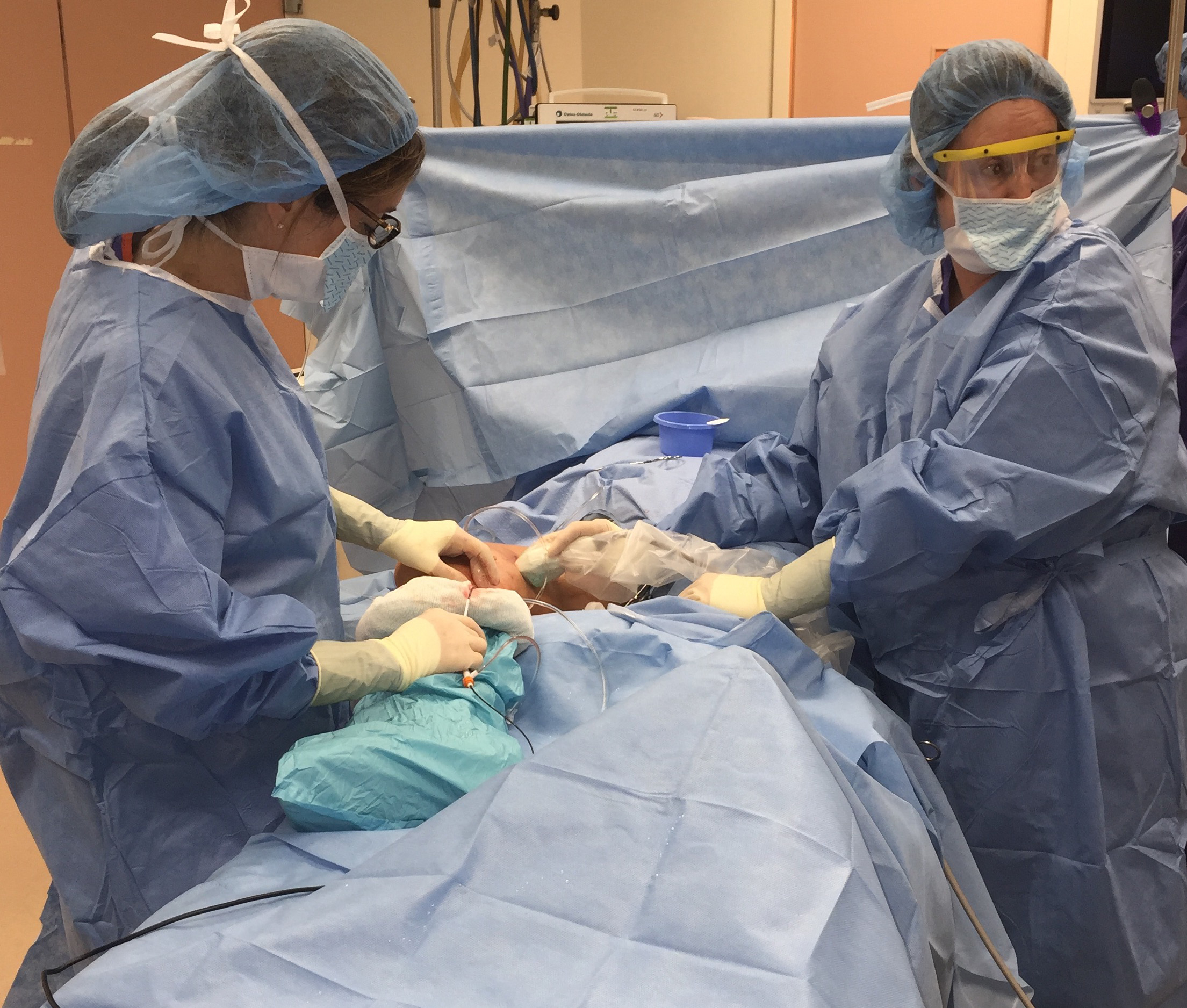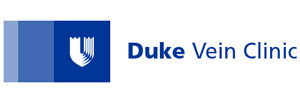
Duplex Ultrasound
 While many patients experience swelling and/or pain due to the varicosities they can see with their own eyes, the most significant problems with venous disease usually lie in the veins that are below the surface. At the Duke Vein Clinic, we use ultrasound as a tool to assess larger, longer, and superficial veins that are just below the surface of the skin.
While many patients experience swelling and/or pain due to the varicosities they can see with their own eyes, the most significant problems with venous disease usually lie in the veins that are below the surface. At the Duke Vein Clinic, we use ultrasound as a tool to assess larger, longer, and superficial veins that are just below the surface of the skin.
Duplex ultrasound allows our doctors to see problematic veins in two ways:
- Using sound waves, we can assess the structure, size, and location of veins
- We can also evaluate aspects of blood flow, such as direction of flow and degree of accumulation, allowing us to see precisely where problems are occurring.
Other advantages of duplex ultrasound are that it is non-invasive, it determines if there are harmful blood clots, it helps your doctor determine the best type of treatment for you, and it assists in many of the procedures that we use.
Sclerotherapy
Sclerotherapy is a venous treatment procedure that involves injection of a liquid or foam solution directly into the vein in order to cause spasm and closure of the vein. This eliminates further accumulation of blood within the vessel, while structures around the vein remain unaffected. The vein itself eventually collapses and vanishes as it is absorbed into the body.
This particular procedure has proven to be an effective and safe non-surgical treatment for veins of all sizes. Other benefits of sclerotherapy are that it is minimally invasive, it is almost completely pain free, there is a fast recovery time, it does not require anesthesia, and it can be performed right here in the clinic. Most patients require at least two sessions of sclerotherapy for complete treatment of veins. In most cases a series of sessions will be required to effectively treat your veins, particularly in the most problematic cases.
At our Raleigh-Durham vein treatment centers, we provide the latest in sclerotherapy techniques to help ensure rapid elimination of troublesome venous diseases.
Ambulatory Phlebectomy/Microphlebectomy
In certain cases, varicose veins at the surface of the skin are too large to treat with sclerotherapy but too small to treat with endovenous ablation. Ambulatory phlebectomy, also referred to as microphlebectomy, may be useful in these cases, as troublesome veins are removed through small skin punctures, sometimes as small as 1mm in length. This procedure allows physicians to remove problematic varicosities through tiny incisions that rarely require stitches.
The procedure itself is minimally invasive, leaves virtually no scars, usually only requires local anesthesia, and is frequently used in combination with sclerotherapy for comprehensive treatment of veins. With this procedure, patients are usually asked to wear compression dressings for one week, but there is little down time, physically. In fact, patients can usually stand and walk after the procedure and even return to work the next day.
Endovenous Ablation
 Endovenous ablation is designed to close large, long veins by using targeted heat energy inside the vein. There are two types of endovenous ablation: endovenous laser ablation and radio frequency ablation.
Endovenous ablation is designed to close large, long veins by using targeted heat energy inside the vein. There are two types of endovenous ablation: endovenous laser ablation and radio frequency ablation.
Endovenous Laser Ablation (EVLA)
EVLA is a fast, nearly painless, minimally-invasive procedure used to treat varicosities in superficial veins. During the procedure, an ultrasound is used to show the position of the vein, and then the treatment area is locally anesthetized. A tiny laser fiber is inserted into the affected vein, delivering short waves of energy inside the vein. This energy warms the vein causing it to shrink and collapse. Patients are almost always able to walk shortly after the procedure, and are usually completely back to normal in a couple days.
Radio Frequency Ablation (RFA)
RFA is another minimally invasive procedure that uses ultrasound to guide a radiofrequency catheter into an abnormal vein. The vessel is exposed to radio energy, which leads to closure of the vein. As with EVLA, after the vein is closed healthy veins take over and reestablish a more efficient flow of blood. Also similar to EVLA, RFA is fast, typically pain free, and has low potential for side effects and complications.
Both EVLA and RFA are popular because of their simplicity, their need for local anesthesia only, and their minimal invasiveness, low risk, minimal scarring, and fast treatment and recovery times.
Cutaneous Laser
The CoolTouch cutaneous laser was originally designed for cosmetic treatment of aging facial skin and acne scarring. However, it has recently been shown to be useful for the treatment of spider veins. During cutaneous laser treatment, laser energy is applied in a series of gentle pulses over the treatment area. The laser energy is absorbed by the spider veins and as they are heated, the blood in the vessels clots, and the body absorbs the treated veins in a natural healing process.
Cutaneous laser therapy has a unique ability to selectively target blood vessels but refrain from injuring surrounding tissue. Like other treatments, it can be performed in the office setting, there’s no down time, and it is virtually risk- and pain-free.
Compression Therapy
Compression stockings and socks are worn to increase blood circulation, most often in the legs. Unlike other types of socks and stockings, compression stockings use tighter, stronger elastic to create pressure and alleviate problems with circulation. The pressure applied to the legs by compression stockings is measured in mmHg, and the stockings are available in a range of pressures, most often between 8 and 40 mmHg. They work by compressing veins, arteries and muscles near the surface of the affected area, resulting in blood that is circulated through narrower channels. Blood pressure in the arteries increases, and more blood is able to return through the veins to the heart rather than accumulate or flow backwards.
Compression stockings are used to treat several venous diseases such as varicose veins, venous stasis ulcers, and others. They are also frequently used after procedures on larger veins in order to enhance blood flow and speed recovery. The stockings are designed for both females and males, and are made from comfortable elastic, nylon, or lycra. Designed to be worn throughout the day, compression stockings are available in several colors and styles in order to blend in with skin tones. Benefits of compression stockings are that they are simple, non-invasive, risk-free, and removable.
For additional information on any of the services listed above, please contact us to speak with one of our experienced, knowledgeable clinical staff members.
We are a short drive away for most cities in the greater Research Triangle region, including Cary, Chapel Hill, Burlington, Elon, Graham, Hillsborough, Oxford, Henderson, Wake Forest, Knightdale, Clayton, Garner, Apex, Zebulon, and Benson.

